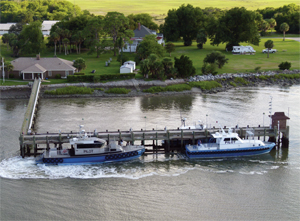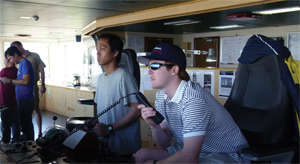At 1630 hours, the radio chatter rang out: “Sécurité call, Savannah River, Argos outbound approaching Talmadge Bridge, any concerned traffic, standing by on Channel 13, Argos.” Soon after, the walkie feature on the cellphone of Savannah Pilot 32, Todd Missroon Jr., came to life.
Missroon was piloting the ZIM-chartered containership Argos toward the Atlantic Ocean. Pilot 31, Kason Fritts, was on the bridge of the post-Panamax CMA-CGM containership Pacific Link, which was coming out of Tybee Roads and approaching the Savannah River, where it eventually arrived at Container Berth 6 at GPA-Garden City in the Port of Savannah. Conversation turned to a passing arrangement for where the two ships would meet.
“The current is still running, so I can make decent time, but I’ll still need a heads-up before you get to Bight Channel so we can make a good meet. I’d prefer to meet on the straightaway there.” Bight Channel is a straightaway in the river. The Savannah River, unlike the wide-open ports of New York and New Jersey or Baltimore, has a fairly narrow passing lane for two ships as they meet. Bight Channel is only 500 feet wide with a depth of 42 feet. Argos is 865 feet in length with a 108-foot breadth.
 |
|
Missroon and apprentice Paul King climb the Jacob’s ladder on the containership Lena-S. |
Pacific Link is 1,095 feet long and has a breadth of 141 feet. Between the two of them, they take up approximately 250 feet of the river. There is 80 feet separating the two ships from one another, and another 80 feet on either side of the ships and the navigable channel. However, it’s one of the straighter areas in the river, which allows for optimal passage.
At 1742 it was time to meet, and the orders of “slow ahead” and “starboard 10” were given to begin navigating through the big turn while negotiating past the larger Pacific Link. Unfortunately, the times didn’t match, and the two ships met in the bend in the river just west of the straightaway. However, the bend is still considered a part of Bight Channel and therefore didn’t affect the meet, but just made for some different calculations on the part of the two pilots. After the meet, Argos hit the straightaway and continued on a steady course for Tybee Roads, at which point the order of “full ahead” was given.
For this run, things were fairly normal for Missroon, 23, a certificate pilot, who would become a full-fledged branch pilot a couple months later. In a little over six years, four as an apprentice and two as a certificate pilot, he has become quite knowledgeable about the river. Interestingly enough, he finds the larger ships to be more manageable.
 |
|
The containership Argos reaches Bight Channel, where it meets the CMA-CGM containership Pacific Link. |
“As I have moved up in tonnage, I’ve seen that it’s actually a bit easier to pilot an 800-foot containership than a smaller 600-foot tanker. The tankers are usually underpowered,” he said. “Current, state of tide and depth, visibility, the area you meet in — you try to meet in a favorable spot, but that’s not always possible. Bight Channel, where we are, can be good if on the straightaway, not the curve.”
Capt. Valeriy Komarnytsky on Argos gave high praise to the young pilot. “Any concerns I had about passing another ship in the narrow river were mollified by the pilot. The pilot has done a good job,” he said. Komarnytsky, 41, has been a captain for 11 years. The last time he was in Savannah was 14 years ago as a chief officer for another company. “As the river gets dredged and thus made deeper, it will be good for bigger vessels to come in,” added Komarnytsky.
The dredging referenced by Komarnytsky is the major undertaking that has just started in the Savannah River. The project will increase the depth of the river, as well as the shipping channel in Tybee Roads, from 42 feet to 48 feet. The dredging is projected to last for five years, and the end product will allow larger post-Panamax, and possibly even neo-Panamax ships, to transit the river. However, not everyone shared the same upbeat sentiments as Komarnytsky.
 |
|
The pilot boat Georgia’s GPS system shows that the boat, which just picked up a pilot, has entered the Savannah River from Tybee Roads. |
In a previous conversation with another pilot, Rob King, different views were expressed. “Despite the deepening of the channel to 48 feet, it won’t be of any advantage when it comes to ships of extreme depth and breadth — those exceeding 131 feet across,” King said. “Two of those ships passing will be difficult since, while the channel will be deeper, it won’t be any wider. It will be U-shaped with a V at the bottom. With bigger ships, even if the bottom is deeper, the sides are shallower. If two such ships meet, there is less room for error.”
Later on, after disembarking from Argos and having safely piloted a tanker ship into the port, night fell and it was time to part ways with Missroon and meet another pilot, George Henry, a branch pilot with 25 years of experience. On the way to the next job, Henry gave his thoughts on the dredging of the river.
“In 25 years, the biggest changes are that the ships have gotten bigger; 850 feet was big, 950 feet was huge. Now, 1,150 feet is big, and 1,000 feet is normal,” Henry said. “The ships have gotten bigger, and the river has gotten smaller by comparison. When the dredging is completed, wider ships will come, making it more difficult to pass. When it comes to passing, if the ship approaches at too high a rate of speed or if the ship gets too close to the channel wall, you risk dragging, grounding, etc.”
At 0030, as Henry contemplated the changes that were coming, the 2013-built pilot boat Georgia, the newest boat in the fleet, brought the crew swiftly away from the pilot base toward the sea buoy, which marks the border between Tybee Roads and the ocean. Flying along at 32 knots, the two Hamilton H521 waterjets propelling Georgia, powered by two 12V M72 MTU engines, made easy work of the 2- and 3-foot swells. The engines produce 1,450 hp each. The boat was built by Kvichak Marine of Seattle and is 64 feet in length with a 3-foot draft. It is set up for two crew and seven pilots, with a day galley, a head, a bunkroom for four pilots, 1,200 gallons of fuel and 200 gallons of water.
 |
|
Evergreen containership Ever Delight approaches the Talmadge Memorial Bridge as it heads down the Savannah River toward Tybee Roads and the Atlantic Ocean. |
As the sea buoy approached at about 0100, the next job came into view — the incoming roll-on/roll-off cargo ship Wedellsborg, owned by Nordana. Wedellsborg is an interesting ship in that it’s rather small at only 587 feet in length and 88 feet in breadth, while drawing only 20 feet. Wedellsborg is a twin-screw ship, as opposed to most ships that call port in Savannah or elsewhere, which only have one main engine and a single propeller. Built in 2014, Wedellsborg is versatile with state-of-the-art features including computer screens, bow thrusters and more, which make for easier transiting of the river and subsequent berthing at the terminal. One unusual aspect is that the wheelhouse is forward of the rest of the ship and has a very small bow, which makes it challenging to navigate with regards to sight distances when lining up the bow with the range lights.
Capt. Francesco Suma of Wedellsborg had this to say about the river: “The most difficult issue is usually the tide or the current. It can be hard for a ship of our size to fight the current if we have to turn in the river and go in the opposite direction than where we were initially going.” Luckily, the turning and docking was left to the steady hands of the knowledgeable Crescent Towing docking master Capt. Audie Dragon.
In over 35 years of work with Crescent, Dragon has seen it all. The future increase in river depth intrigues him.
“With potential for more ships, we’ll have to use more tractor tugs. They’ll give us considerably more reliability and versatility than conventional model bow tugboats,” he said.
 |
|
The pilot boat Georgia, left, prepares to depart the Savannah Pilots base dock at Cockspur Island. The pilot boat Carolina, right, awaits its next call. |
A colorful figure, Dragon was making quick work of turning Wedellsborg in the river and docking it at Liberty Terminal while keeping in constant contact with his two tugboats.
Over the next few minutes, Dragon worked his magic. “How are we looking, Bulldog? All right, good deal. Come on around, Kelly. Half astern! I wouldn’t go that way, Kelly, but go on. Full astern. Bow full to port. Kelly, get up on that stern if you can. Stop the bow. Bow full to starboard. Bulldog, take that line up, come back alongside and slide in with it. Dead slow ahead. Slow ahead. Stop engine. Bulldog, get in position. All right, Kelly, you can drop back a bit. Get in tight, Bulldog. Let me know when you can push, Bulldog. Put 20 percent into it, Bulldog. Dead slow astern. Kelly, you can take off a bit. Stop, Bulldog. Slow astern. Bow half to port. How far we gotta come back now? Forty feet? All right. We’ll try to land it here and go back. You’re getting the spring line out now? Holy smokes. OK, good deal. Ten percent, Bulldog. Any lights back there? Let’s have them on. Stop, Bulldog. Back 10 percent, Bulldog.”
By 0400, after a bit of work and great communicating between the two tugboats, Wedellsborg was safely in the berth at Liberty Terminal and was ready to unload. Another job well done by the docking master and the Savannah Pilots. Day in and day out, at all hours, in all sorts of weather, the Savannah Pilots bring ships in to the port. What will the future hold with the prospect of deeper waters? Will larger ships bring more business? Will navigating the Savannah River and Tybee Roads be much improved, or more of the same? Only time will tell.

